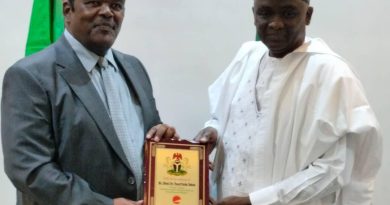Adamawa Waits On Borno To Close IDP Camps
By Bukar Bolori
The Adamawa State Government on Wednesday said it was waiting on Borno State Government to evacuate internally displaced persons from camps in the state in order to finally close them down.
Speaking in Abuja on Wednesday at a workshop on “Advancing Durable Solutions Pathway” sponsored by the United Nations High Commissioner for Refugees (UNHCR), the Executive Secretary, Adamawa State Emergency Management Agency, Dr. Mohammed Amin Suleiman, said Borno State indigenes make up 80 percent of inhabitants of IDP camps in Adamawa and for the camps to be close they have to move back to their state.
He said: “I was in Maiduguri last week where we have finalized arrangements with the Borno State government on getting the IDPs from their state evacuated, and immediately this is done we are going to close down the IDP camps in Adamawa State.”
Suleimon said the Adamawa State Governor, Hon. Ahmadu Umaru Fintiri has given a nod for the closure of the IDP camps and it could be closed any moment from now.
He, however, expressed appreciation over the contributions of UNHCR on issues concerning accommodation for the IDPs, stating that it well a great collaboration with Adamawa State Government by UNHCR that have brought smiles on the faces of many displaced persons.
Speaking at the event, the UNHCR Representative in Nigeria, Ms. Chanda Kapaya noted that the propose of the workshop was to address the pressing challenges of internal displacement and support reintegration of self-organized refugee return in Nigeria’s north eastern region, with special focus on Adamawa State.
Kapaya, who was represented by the Assistant Representative, UNHCR Nigeria, Mr. Gilbert Mutai lamented that over the past decade, the number of internally displaced persons worldwide has doubled, reaching a record high of 55 million.
She said: “In 2021 alone, conflict, violence, and disasters triggered a staggering 38 million internal displacements across 141 countries and territories, as reported by the Internal Displacement Monitoring Centre (IDMC).”
She lamented that: “With no immediate solutions available for the vast majority, displaced communities have been forced to live for generations without the ability to plan for their future or exercise their human rights. The persistence of these crises calls for a reassessment of our approaches to securing durable solutions for the forcibly displaced.”
She said as a result of intertribal clashes and natural disasters, millions of individuals have been displaced in the Northeast with Borno having 1,640,408 individuals and Adamawa and Yobe having 223,910 and 151,366 respectively.
She noted that in Adamawa State, with the establishment of government-led mechanisms, such as the Durable Solutions Steering Committee and the Technical Working Group on Durable Solutions, has created momentum to advance solutions for the displaced and their host communities.
Kapaya said that UNHCR’s pilot project, the Labondo Local Integration Project in Adamawa State, is one of the initiatives that exemplifies a multi-sectoral, area-based approach that prioritizes community empowerment, sustainable housing, socioeconomic development.
She explained that: “As we move forward, ensuring the sustainability and scalability of these initiatives is crucial and will require the expertise and financing of development partners,” stressing that: “Through our combined efforts, we can build upon the progress made so far and ensure that the project continues to improve the lives of those in need.”




